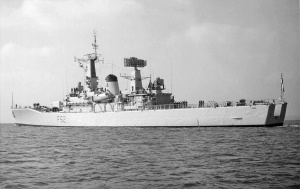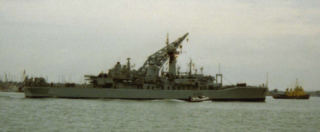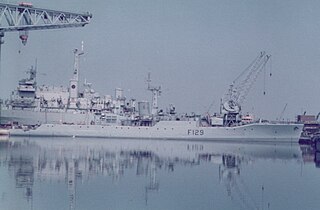
HMS Argonaut (F56) was a Leander-class frigate that served with the Royal Navy from 1967 to 1993. She took part in the Falklands War in 1982, sustaining damage and casualties in action.

HMS Andromeda was a Leander-class frigate of the Royal Navy. She was built at HM Dockyard Portsmouth. She was launched on 24 May 1967 and commissioned into the Royal Navy on 2 December 1968. She took part in the Falklands War. She was sold to India in 1995, for use as a training ship, being renamed INS Krishna. She was finally decommissioned in May 2012.
HMS Minerva (F45) was a Leander-class frigate of the Royal Navy. The ship commissioned in 1966 and took part in the Beira Patrol and Second Cod War during the 1970s and the Falklands War in 1982. Charles, Prince of Wales served aboard the ship in the 1970s. Between these major engagements, the frigate patrolled British territorial waters and took part in NATO and British military exercises. Minerva was decommissioned in 1992 and sold for scrap.

HMS Galatea (F18) was a Leander-class frigate of the Royal Navy. She was built by Swan Hunter & Wigham on the Tyne. She was launched on 23 May 1963 and commissioned on 25 April 1964 and was the eighth ship of the Royal Navy to bear the name.

HMS Charybdis (F75) was a Leander-class frigate of the Royal Navy (RN). She was built by the Harland & Wolff company of Belfast, and was the last ship to be built there for British naval forces until RFA Fort Victoria of the Royal Fleet Auxiliary, was launched in 1990. Charybdis was launched on 28 February 1968 and commissioned on 2 June 1969. Her nickname was "Cherry B".

HMS Leander (F109) was the nameship of the Leander-class frigate of the Royal Navy (RN). She was originally intended to be part of the Rothesay class and would have been known as Weymouth. Leander was, like the rest of the class, named after a figure of the classical Greek mythology. She was built by the Harland & Wolff shipyard in Belfast, Northern Ireland and was launched on 28 June 1961. She was commissioned on 27 March 1963.

HMS Euryalus (F15) was a Leander-class frigate of the Royal Navy (RN). Like the rest of the class, Euryalus was named after a figure of mythology. Euryalus was built by Scotts Shipbuilders of Greenock. Euryalus was launched on 6 June 1963, and commissioned on 16 September 1964.

HMS Cleopatra (F28) was a Leander-class frigate of the Royal Navy (RN). Cleopatra was built at HMNB Devonport. She was launched on 21 March 1964, commissioned on 1 March 1966 and decommissioned on 31 January 1992.

HMS Hermione (F58) was a Leander-class frigate of the Royal Navy (RN). She was, like the rest of her class, named after a figure of mythology. Hermione was built by Alexander Stephen and Sons, though she was completed by Yarrow Shipbuilders. She was launched on 26 April 1967 and commissioned on 11 July 1969.

HMS Arethusa was a Leander-class frigate of the Royal Navy. She was, like most of the Leanders, named after a figure of mythology. Arethusa was built by J.S. White & Company Shipbuilders of Cowes, launched on 5 November 1963 and commissioned on 24 November 1965.

HMS Ariadne was a Leander-class frigate of the Royal Navy. She was launched in 1971, was sold to Chile in 1992 and sunk as a target hulk in 2004.

HMS Juno was a Leander-class frigate of the Royal Navy (RN). Like the rest of the class, Juno was named after a figure of mythology. She was built by Thornycroft of Woolston, Hampshire. Juno was launched on 24 November 1965 and commissioned on 18 July 1967.

HMS Sirius (F40) was a Leander-class frigate of the Royal Navy (RN) built by H.M. Dockyard Portsmouth, and was the penultimate RN warship to be built there for a period of forty years, until Vosper Thornycroft built HMS Clyde. Sirius was launched on 22 September 1964 and commissioned on 15 June 1966. The ship continued in front line service until February 1992.

HMS Jupiter (F60) was a Batch 3 Leander-class frigate of the Royal Navy (RN). She was, like the rest of the class, named after a figure of mythology. Built by Yarrow Shipbuilders of Scotstoun, she was launched on 4 September 1967 and commissioned on 9 August 1969.

HMS Danae was a Leander-class frigate of the Royal Navy. She was, like the rest of the class, named after a figure of mythology. Danae was built by Devonport Dockyard. She was launched on 31 October 1965 and commissioned on 10 October 1967.

HMS Tartar (F133) was a Tribal-class frigate of the Royal Navy (RN). She was named after the Tartar people, most of whom were located in Asia and Eastern Europe. She was sold to the Indonesian Navy in 1984 as KRI Hasanuddin (333).

HMS Duncan, launched in 1957, was the fifth RN ship named after Admiral Adam Duncan. She was a Blackwood-class frigate of the Royal Navy that served in the Cod Wars.

HMS Hardy was an anti-submarine warfare frigate of the Blackwood class or Type 14. She was named after Thomas Masterman Hardy, Captain of HMS Victory at Trafalgar. Hardy was the first Type 14 frigate built, completed on 8 December 1955, by Yarrow Shipbuilders.

HMS Rhyl was a Rothesay-class or Type 12M anti-submarine frigate of the Royal Navy, launched by Lady Macmillan on 23 February 1959 and commissioned in October 1960. Following Royal Navy service she was scuttled whilst being prepared as a target in 1985.

HMS Salisbury was a Salisbury-class or Type 61 aircraft direction frigate of the British Royal Navy. Completed in the late 1950s, Salisbury served through the 1960s and 1970s, participating in the Beira Patrol, blockading against Rhodesia and the confrontation with Iceland over fishing rights that was known as the Cod Wars. Salisbury became a harbour training ship in 1980, before being sunk as a target in 1985.




















